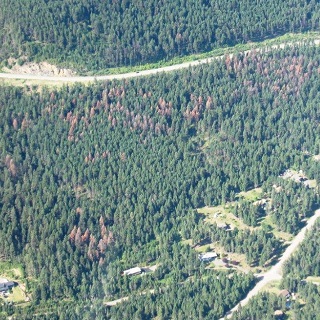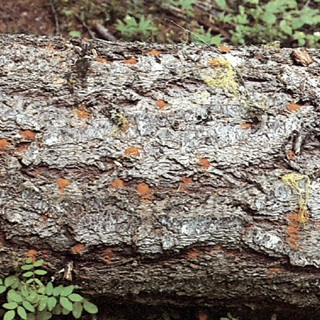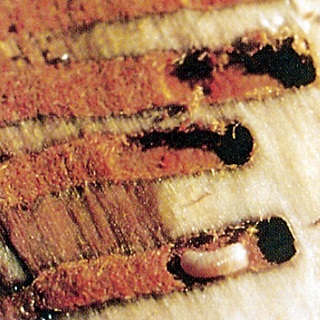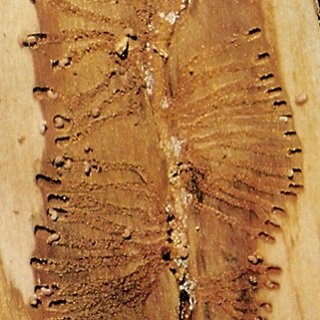Douglas-fir beetle
Dendroctonus pseudotsugae
The Douglas-fir beetle is one of the principal killers of mature Douglas-fir in B.C. and usually attacks weakened or dying trees. Occasionally the beetle populations increase to the extent that it infests and kills large numbers of healthy trees.
On this page
Description
This beetle is most common in B.C.'s Interior. It can also be found in coastal forests but rarely causes the large-scale damage seen inland.
The beetle attacks the host trees in early summer usually targeting weakened trees (for example, drought or wildfire damaged trees) or trees blown down by windstorms. When it attacks healthy trees, the beetle targets the largest and oldest first.
Adult Douglas-fir beetles are dark brown to black with reddish wing covers, and are tiny (about 4.4mm to 7mm long). The life cycle is usually one year, and two broods may be produced.
Regardless of brood, Douglas-fir beetle progresses from egg through four larval instars to pupa and finally to adult.”
The beetles' life cycle is as follows:
- Adult females emerge when ambient air temperature exceeds approximately 16 degrees Celsius, find new suitable host material, and emit aggregating pheromones to initiate mass attack
- Males join the females and each pair construct an egg gallery under the bark, parallel to the grain
- The sapwood is inoculated with spores of a blue stain fungus as the egg gallery is built
- Eggs are laid and hatch into larvae which feed on the phloem in feeding channels constructed at right angles to the egg gallery
- After four instars, larvae pupate and develop into adults under the bark
- Young adults pick up blue stain fungal spores while in the pupal chamber
The timing of life-cycle events for any species of bark beetle can vary from year to year and from location to location due to variations in climate and local weather.
The action of the larval feeding in the phloem and fungal colonization of the sapwood completely blocks the water uptake and kills the infested tree. In some cases, only one side of a tree will be successfully attacked (strip attack); this tree will survive unless living portions are reattacked in subsequent years.
Host tree species
Native to North America, this insect is found throughout the range of the Douglas-fir, its principal host. Large diameter, mature Douglas-fir trees are attacked.
Douglas-fir beetle occasionally attacks downed western larch.
Damage symptoms
Foliage of killed trees turns from green to light yellow then orange to bright red, usually by the spring of the year following the attack. Colour change can take up to 15 months, which can delay identification of infested trees. Red needles may remain for up to two years after an attack, and aerial spotting of these "redtops" helps to determine the extent of an outbreak.
Adults and larvae boring under the bark leads to the accumulation of reddish boring dust, or frass, in the bark crevices and at the base of the tree. Pitch tubes are not formed, but the tree may exude resin from attacks in the upper trunk (pitch streamers).
Similar damage by other insects
Mining by other wood boring insects (family Buprestidae and family Cerambycidae) or carpenter ants can be mistaken for Douglas-fir beetle. These other insects can be distinguished from Douglas-fir beetle by the whitish-red colour of their boring dust at the base of the tree.
The Douglas-fir pole beetle is usually found in the smaller diameter trees in the upper portion of the stem. It can be distinguished from the Douglas-fir beetle by its finer boring dust and different gallery patterns.
Careful attention to boring dust colour and gallery patterns is necessary to avoid confusing these insects with Douglas-fir beetle.
Identification images
Adult Douglas-fir beetle
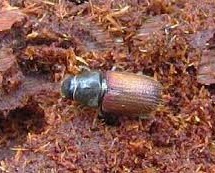
Further reading
For more information about the Douglas-fir beetle, read the Field Guide to Forest Damage in B.C. (PDF, 6.6MB)

